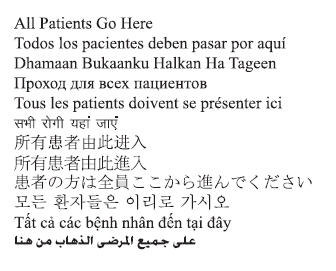FYI, There’s been some drama about Clinical Reader and it’s unauthorized use of images in recent days. MK
A blog post from EBM and Clinical Support Librarians@UCHC alerted me to Clinical Reader, a new site developed that brings you research articles, news and multimedia in one place.
Developed by a junior doctor and a small group programmers spread across London and Toronto, the site uses ISI journal impact factors and Google analytics to choose material for the site.
Readers can browse TOCs from popular clinical journals like NEJM, Gut, Clinical Radiology, BMJ, Pediatrics, and more in a highly visual format, and there are sections for medical students, and medical education, among many others.
LINK:
Clinical Reader: http://clinicalreader.com/
Next week on Wednesday, July 1st the various schools of LSUHSC will be offering screening for high blood pressure, diabetes, depression, lung function, colorectal cancer and oral cancer, as well as vaccinations and education on a variety of health topics. The event will take place from 1 – 6 p.m. at Grace Episcopal Church, 3700 Canal St. It is part of the Congressman Cao AAA Health Care Initiative. For more information, see the official LSUHSC press release.
The FDA has just released a warning for consumers to not eat “prepackaged Nestle Toll House refrigerated cookie dough due to the risk of contamination with E. coli O157:H7.” They recommend that all dough be discarded because handling the dough to cook it could spread the bacteria.
This month AJN, American Journal of Nursing features a case study of a patient that proves this point. A severely disabled man received such poor oral care from nursing home personnel that his oral and nasopharyngeal secretions built up (?óÔé¼?ôinspissated?óÔé¼?Ø), and he died from asphyxia. The lead author, Joseph A. Prahlow, was the pathologist in charge of the autopsy; the article features graphic photos of the thickened secretions that blocked his airway. A companion article by two dentists, Pamela S. Stein and Robert G. Henry, gives nurses suggestions on how they can overcome barriers to providing oral care to patients.
Here is a link to other articles on the subject of oral hygiene of the elderly or patients in long term care.

Hospital sign: “All Patients Go Here” in multiple languages
An article from ACRL News pointed me to a new resource offering health information translations:
Health Information Translations
This resource, sponsored by several medical centers in Ohio, provides education and procedural instructions about health topics for patients with limited English proficiency. Search by keyword or language and retrieve a short document in English about that particular health issue followed by the translation of the article. Some documents have audio files. For example, the document on ?óÔé¼?ôbreast biopsy?óÔé¼?Ø explains the different kinds of biopsies, the procedure the physician will follow and instructions for the patient, all in Spanish. This is a source for timely, accurate medical vocabulary as well as practical application, since the translation of common procedures and instructions into Spanish is ready to be handed out to the patients. Includes translations of disaster preparedness plans. Access: http://www.healthinfotranslations.com/.
One of the best things I like about it are the common hospital signs with multiple translations (see photo above). The signs are available for download in PDF format for free on their site.
The city of New Orleans has been chosen as one of the 100 sites for the Healthy Start Program.
According to The Gambit’s Blog of New Orleans, “Healthy Start is a federally-funded initiative that was introduced in 1991 to lower the alarmingly high rate of infant mortality in the United States by addressing the disparity in prenatal care afforded women at different economic levels.”
Take the time to learn more about this great initiative providing prenatal and postnatal care to the women and children of our city.
You can now easily track disciplinary action against physicians and other licensed health care professionals in Louisiana through the Louisiana State Board of Medical Examiners homepage.
http://www.lsbme.louisiana.gov/
There is even an RSS feed available, so you could set up a folder in your Microsoft Outlook email to track who’s been reprimanded, warned or summarily suspended from practice in our fair state. More info on setting up RSS in Outlook here.
A Harvard Psychiatrist Explains Zombie Neurobiology
In Night of the Living Dead, zombies are brought back from the dead by a “mysterious force” that allows their brains to continue functioning. But how exactly does a zombie brain function? Finally, a Harvard psychiatrist has the answers.
Through education Dr. Steven C. Schlozman is an assistant professor of psychiatry at Harvard Medical School and a lecturer at the Harvard School of Education. He is also an avid sci-fi and horror fan – and, apparently, the world’s leading authority on the neurobiology of the living dead. He has even drafted a fake medical journal article on the zombie plague, which he calls Ataxic Neurodegenerative Satiety Deficiency Syndrome, or ANSD (the article has five authors: one living, three “deceased” and one “humanoid infected”).
Check out some of the scholarly articles Dr. Schlozman has published.
The Ische’ Library has a large selection of Neurobiology books if you would like even more info.
The National Headache Foundation has declared that June 7-13, 2009 is National Headache Awareness Week.
Over 45 million Americans suffer from chronic, recurring headaches, with over half of these classified as migraines.
Headaches have numerous causes. Correctly diagnosing and treating a headache patient depends primarily on establishing an accurate and open line of communication.
The American Headache Society provides information on a variety of resources available to patients and medical professionals that are dedicated to the study and treatment of headache. Learn what you can do to help stop the pain.
The Center for Disease Control and Prevention has published a document, Prevention of Swine Influenza A (H1N1) in the Dental Healthcare Setting. This document provides guidance for dental health care providers for treating patients with acute respiratory infections and influenza. It is recommended that all health care professionals continue to check the CDC’s H1N1 website regularly.
The American Dental Association has also published information on the topic: H1N1 Flu.
Also, the Organization for Safety & Asepsis Procedures, a US based organization dedicated to promoting infection control and safety policies and practices supported by science and research to the global dental community, has published Novel Influenza A (H1N1) Virus Resources for Dental Professionals.
Memorial Day is upon us again. And while it is the official start of summer in much of the US, it is most importantly a “day of remembrance for those who have died in our nation’s service.”
In honor of this day, here are a couple of interesting websites for the veterans or families of veterans:
MedlinePlus: Veterans & Military Health
Veterans History Project from the Library of Congress
National Institute of Allergy & Infectious Diseases (NIAID) provides Fact Sheets, Brochures, and Questions & Answers about HIV vaccine research and trials.
HIV Vaccine Researchers are working to develop a vaccine that is 100 percent effective and will protect everyone from HIV infections. HIV research is essential for Louisiana citizens. Look at the facts below.
HIV/AIDS in Louisiana FACTS
?óÔé¼?ó As of March 31, 2008 a cumulative total of 27,744 persons have been diagnosed with HIV/AIDS in Louisiana, including 302 cases in children under the age of 13.
?óÔé¼?ó There are persons living with HIV in every parish in Louisiana, and this number continues to increase each year, largely due to more effective drug therapies.
?óÔé¼?ó A total of 15,795 persons were known to be living with HIV/AIDS in Louisiana, of which 8,281 (52%) had been diagnosed with AIDS as of March 31, 2008.
?óÔé¼?ó In 2007, 1,152 new HIV cases were diagnosed in Louisiana; 30% of the cases were in Region 1 (New Orleans area) and 28% were in Region 2 (Baton Rouge area).
?óÔé¼?ó In 2007, 803 new AIDS cases were diagnosed in Louisiana. Of these cases, 33% occurred in Region 1 (New Orleans) ad 27% occurred in Region 2 (Baton Rouge).
?óÔé¼?ó In 2006, Louisiana ranked 5th highest in state AIDS case rates and 12th in the number of AIDS cases diagnosed in 2006.
?óÔé¼?ó Baton Rouge ranked 4th for AIDS case rates among the largest metropolitan areas in the U.S. in 2006; New Orleans ranked 8th.
?óÔé¼?ó In Louisiana, 30% of new HIV cases and 31% of new AIDS cases are among women.
?óÔé¼?ó HIV continues to disproportionately affect African Americans in Louisiana. In 2007, 72% of newly diagnosed HIV cases and 75% of newly diagnosed AIDS cases were among African Americans.
May is National High Blood Pressure Month and it’s a good time to get to know your numbers.
Blood pressure is the force of blood against the artery walls. It is stated as a set of two numbers, the top (systolic pressure) measures the force of your heart beating and the bottom (diastolic pressure) measures the relaxation between beats.
According to the National Heart, Lung and Blood Institute, a high blood pressure diagnosis results when you have repeated readings of 140 over 90. Pre-hypertension is the term given to readings from 120 to 139 over 80-89.
High blood pressure is considered a “silent killer” because often there are no symptoms at first. Through time, uncontrolled high blood pressure can lead to stroke, heart attack, heart failure, or kidney failure.
More than 72 million American adults, 1 in 3, have high blood pressure. Although certain risk factors, such as age or family history, can’t be controlled, we can make lifestyle changes to help maintain a healthy blood pressure.
Get yourself checked. Learn your numbers now.
In a long list of health observances, May brings you “Better Sleep Month.”
This awareness comes at a perfect time; as the days get longer and hotter, and people make time for well-deserved rest and relaxation.
Getting the right amount of sleep is just as important as a healthy diet and exercise. However, factors like stress and sleep illnesses can interrupt a satisfactory night’s rest.
Visit The Better Sleep Council to learn interesting sleep statistics, common sleep problems and to discover the interesting history of our wonderful friend, The Bed.

This year the 10th annual National Women?óÔé¼Ôäós Health Week kicks off today!?é?á It is a weeklong health observance coordinated by the U.S. Department of Health and Human Services?óÔé¼Ôäó Office on Women?óÔé¼Ôäós Health (OWH). This year?óÔé¼Ôäós theme is ?óÔé¼?ôIt?óÔé¼Ôäós Your Time?óÔé¼?Ø.

Some tips to increase physical and mental health include:
Locally there are a few events that are taking place:
Taking it to the Streets ?óÔé¼ÔÇ£ A City Walk and Lunch promoting women?óÔé¼Ôäós mental and physical health (http://www.tulane.edu/~tuxcoe/NewWebsite/com_womens_health/index.html)
Ask your Health Provider ?óÔé¼ÔÇ£ Clinical screening & exam, HIV & STI treatment and/or prevention, Taking the Pledge! (http://www.dhh.louisiana.gov/offices/?ID=264)
So far, Louisiana only has 6 women who took the pledge and is trailing far behind Missouri which has 155 pledges, so take the pledge today!
One week, not enough?
If you?óÔé¼Ôäód like to continue the Woman Challenge there is an eight-week online activity program that allows you to track your progress, so sign up today!

For more information please visit http://www.womenshealth.gov/whw/ .

 myLSUHSC
myLSUHSC


